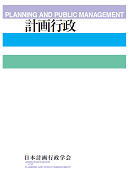Volume 28, Issue 1
Displaying 1-35 of 35 articles from this issue
- |<
- <
- 1
- >
- >|
New Development in Planning Administration: Partnership with Asia
Introductory Remark
-
2005Volume 28Issue 1 Pages 1-2
Published: March 15, 2005
Released on J-STAGE: April 05, 2024
Download PDF (3043K)
Conference Program
-
2005Volume 28Issue 1 Pages 3-4
Published: March 15, 2005
Released on J-STAGE: April 05, 2024
Download PDF (1816K)
Key Note Address
-
2005Volume 28Issue 1 Pages 5-14
Published: March 15, 2005
Released on J-STAGE: April 05, 2024
Download PDF (12318K)
Symposia
-
2005Volume 28Issue 1 Pages 15-26
Published: March 15, 2005
Released on J-STAGE: April 05, 2024
Download PDF (14490K) -
2005Volume 28Issue 1 Pages 27-42
Published: March 15, 2005
Released on J-STAGE: April 05, 2024
Download PDF (19909K) -
2005Volume 28Issue 1 Pages 43-55
Published: March 15, 2005
Released on J-STAGE: April 05, 2024
Download PDF (16991K)
Research Presentations
-
2005Volume 28Issue 1 Pages 56-58
Published: March 15, 2005
Released on J-STAGE: April 05, 2024
Download PDF (3447K) -
2005Volume 28Issue 1 Pages 59-61
Published: March 15, 2005
Released on J-STAGE: April 05, 2024
Download PDF (3502K) -
2005Volume 28Issue 1 Pages 61-64
Published: March 15, 2005
Released on J-STAGE: April 05, 2024
Download PDF (4679K) -
2005Volume 28Issue 1 Pages 64-66
Published: March 15, 2005
Released on J-STAGE: April 05, 2024
Download PDF (3353K) -
2005Volume 28Issue 1 Pages 66-69
Published: March 15, 2005
Released on J-STAGE: April 05, 2024
Download PDF (4682K) -
2005Volume 28Issue 1 Pages 69-71
Published: March 15, 2005
Released on J-STAGE: April 05, 2024
Download PDF (3594K) -
2005Volume 28Issue 1 Pages 72-74
Published: March 15, 2005
Released on J-STAGE: April 05, 2024
Download PDF (3434K) -
2005Volume 28Issue 1 Pages 75-77
Published: March 15, 2005
Released on J-STAGE: April 05, 2024
Download PDF (3530K) -
2005Volume 28Issue 1 Pages 77-79
Published: March 15, 2005
Released on J-STAGE: April 05, 2024
Download PDF (3474K) -
2005Volume 28Issue 1 Pages 79-81
Published: March 15, 2005
Released on J-STAGE: April 05, 2024
Download PDF (3341K) -
2005Volume 28Issue 1 Pages 82-84
Published: March 15, 2005
Released on J-STAGE: April 05, 2024
Download PDF (3564K) -
2005Volume 28Issue 1 Pages 84-86
Published: March 15, 2005
Released on J-STAGE: April 05, 2024
Download PDF (3047K)
Workshops
-
2005Volume 28Issue 1 Pages 87-88
Published: March 15, 2005
Released on J-STAGE: April 05, 2024
Download PDF (2406K) -
2005Volume 28Issue 1 Pages 89-91
Published: March 15, 2005
Released on J-STAGE: April 05, 2024
Download PDF (3666K) -
2005Volume 28Issue 1 Pages 92-94
Published: March 15, 2005
Released on J-STAGE: April 05, 2024
Download PDF (3424K) -
2005Volume 28Issue 1 Pages 94-95
Published: March 15, 2005
Released on J-STAGE: April 05, 2024
Download PDF (2242K) -
2005Volume 28Issue 1 Pages 95-97
Published: March 15, 2005
Released on J-STAGE: April 05, 2024
Download PDF (3833K)
Scholarship Award and Selection Process
-
2005Volume 28Issue 1 Pages 98
Published: March 15, 2005
Released on J-STAGE: April 05, 2024
Download PDF (1135K)
Winner's Remarks
-
2005Volume 28Issue 1 Pages 99
Published: March 15, 2005
Released on J-STAGE: April 05, 2024
Download PDF (1201K) -
2005Volume 28Issue 1 Pages 100
Published: March 15, 2005
Released on J-STAGE: April 05, 2024
Download PDF (1256K) -
2005Volume 28Issue 1 Pages 101
Published: March 15, 2005
Released on J-STAGE: April 05, 2024
Download PDF (1190K) -
2005Volume 28Issue 1 Pages 102
Published: March 15, 2005
Released on J-STAGE: April 05, 2024
Download PDF (1188K) -
2005Volume 28Issue 1 Pages 103
Published: March 15, 2005
Released on J-STAGE: April 05, 2024
Download PDF (1094K)
Paradigm Shift in Universities
-
2005Volume 28Issue 1 Pages 104-105
Published: March 15, 2005
Released on J-STAGE: April 05, 2024
Download PDF (2129K)
Research Paper
-
2005Volume 28Issue 1 Pages 106-116
Published: March 15, 2005
Released on J-STAGE: April 05, 2024
Download PDF (13406K) -
2005Volume 28Issue 1 Pages 117-122
Published: March 15, 2005
Released on J-STAGE: April 05, 2024
Download PDF (7257K)
Research Note
-
2005Volume 28Issue 1 Pages 123-128
Published: March 15, 2005
Released on J-STAGE: April 05, 2024
Download PDF (8190K)
Local and Regional Planning
-
2005Volume 28Issue 1 Pages 129-135
Published: March 15, 2005
Released on J-STAGE: April 05, 2024
Download PDF (9611K)
Book Review
-
2005Volume 28Issue 1 Pages 136
Published: March 15, 2005
Released on J-STAGE: April 05, 2024
Download PDF (1370K)
- |<
- <
- 1
- >
- >|
